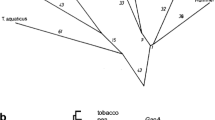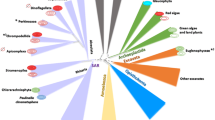Abstract
The evolutionary histories of the 12 enzymes that catalyze the reactions of the Calvin cycle in higher-plant chloroplasts are summarized. They are shown to be encoded by a mixture of nuclear genes of cyanobacterial and proteobacterial origin. Moreover, where cytosolic isoforms of these enzymes are found they are almost invariably encoded by genes of clearly endosymbiont origin. We infer that endosymbiosis resulted in functional redundancy that was eliminated through differential gene loss, with intruding eubacterial genes repeatedly replacing pre-existing nuclear counterparts to which they were either functionally or structurally homologous. Our findings fail to support the `product-specificity corollary', which predicts re-targeting of nuclear-encoded gene products to the organelle from whose genome they originated. Rather it would appear that the enzymes of central carbohydrate metabolism have evolved novel targeting possibilities regardless of their origins. Our findings suggest a new hypothesis to explain organelle genome persistence, based on the testable idea that some organelle-encoded gene products might be toxic when present in the cytosol or other inappropriate cellular compartments.
Similar content being viewed by others
Author information
Authors and Affiliations
Additional information
Received: 8 January / 20 May 1997
Rights and permissions
About this article
Cite this article
Martin, W., Schnarrenberger, C. The evolution of the Calvin cycle from prokaryotic to eukaryotic chromosomes: a case study of functional redundancy in ancient pathways through endosymbiosis. Curr Genet 32, 1–18 (1997). https://doi.org/10.1007/s002940050241
Issue Date:
DOI: https://doi.org/10.1007/s002940050241




